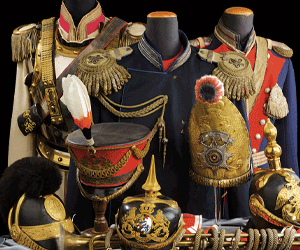Afrikakorps Heer Cavalry Field Cap M35
SKU: 23.GOR.01.03.01.01.01.004
Estimated market value:

Estimated market value:
Attributes
Physical Description
Soutache: bright yellow
History
During the Second World War, German troops stationed in northern Africa are generally referred to as the Afrikakorps. Technically, this is not entirely correct, since some German units operating in Africa were not actually part of the DAK (Deutsches Afrikakorps), and some units of it were, in fact, Italian ones. However, for the purpose of collecting so-called “tropical” uniforms and insignia, collectors have simplified the meaning of the term.
The first German troops were sent to northern Africa in February of 1941, to support their Italian allies against the British. The climate of the African continent made it necessary to wear specialised uniforms and gear that not only supported the soldiers in serving in a hot and arid environment, but also helped them in blending in with the landscape, which, in general, presented itself as brown, olive, khaki, or sand/tan in colour. Worn over long periods of time under the blistering desert sun, some uniforms were eventually bleached to white or off-white. Uniforms and insignia in these colours are often referred to as “tropical”, and it is worth noting that they weren’t just worn by members of units stationed in Africa, but in the entire Mediterranean theatre of war, including southern France, Italy, the Balkans, and Greece, as well as in southern Russia during the summer months. Tropical uniforms were worn by members of all three branches of the Wehrmacht: the Heer (army), the Kriegsmarine (navy), and the Luftwaffe (air force). Members of the Waffen-SS stationed in southerly regions also wore tropical-style uniforms, and even though they technically have no connection to the DAK, all tropical uniforms and insignia of all branches of the German military are listed here.
The Field Cap was introduced in 1934. The earliest of these caps showed a cockade on the top of the front, with a soutache, an inverted chevron, indicating branch colour.
In 1935, the design was slightly changed. From then on, the national eagle insignia was worn on the top of the front, with the cockade and soutache below, on the side panels.
Unlike on other caps, no oak leaves wreath was worn with the cockade on the field cap.
On December 6, 1938 a field cap for those in General or Officer rank was introduced. It is similar to the M35 cap, but better in quality, and emblems were made from metallic thread. The cap was piped in silver for Officer ranks and in gilt for General ranks. There is piping on the top and also on the ear flaps. The soutache is in branch colour for Officers, but in gilt for Generals. The only exception were administrative Generals, who had a dark green soutache.
The M42 Field Cap was introduced on July 21, 1942. It was supposed to be worn by NCOs and EMs only, however piped versions for higher ranks have been observed. With the introduction of this cap, all soutaches were to be removed, but this order was often ignored.
The terms M(odel) 34/35/38/42 were introduced by collectors and have no official character.
Branch colours on German Heer headgear was as follows:
Black was worn by Engineer units.
Black/White was worn by Panzer Engineers.
Copper Brown was worn by Motorcycle personnel.
Carmine was worn by the Führer Staff, General Staff Officers, Staff Officers of the Supreme Command of the Army, and all Veterinary branches.
Bordeaux Red was worn by Smoke & Chemical personnel.
Bright Red was worn by Generals, Artillery units, and Ordnance Officers (until 1944).
Rose was worn by all Armored units (including Panzer troops, and Schützen Brigade Staff).
Orange was worn by Recruiting personnel, Ordnance troops, Ordnance Officers (since 1944), and Field Gendarmerie units.
Bright yellow was worn by Cavalry units, and Light Division Staff.
Lemon yellow was worn by Signal units.
White was worn by Infantry units.
Light Grey was worn by Propaganda personnel.
Grey-Blue was worn by Sonderführer (Specialist Officers).
Violet was worn by Chaplains and Field Bishops.
Cornflower Blue was worn by Medical units, and Supply units.
Bright Blue was worn by Transport troops.
Bright Green was worn by Jäger and Mountain units.
Grass Green was worn by Panzer Grenadier units (Armored Infantry).
Dark Green was worn by Administrative personnel.


Comments
Sign in to comment and reply.


Scroll Top